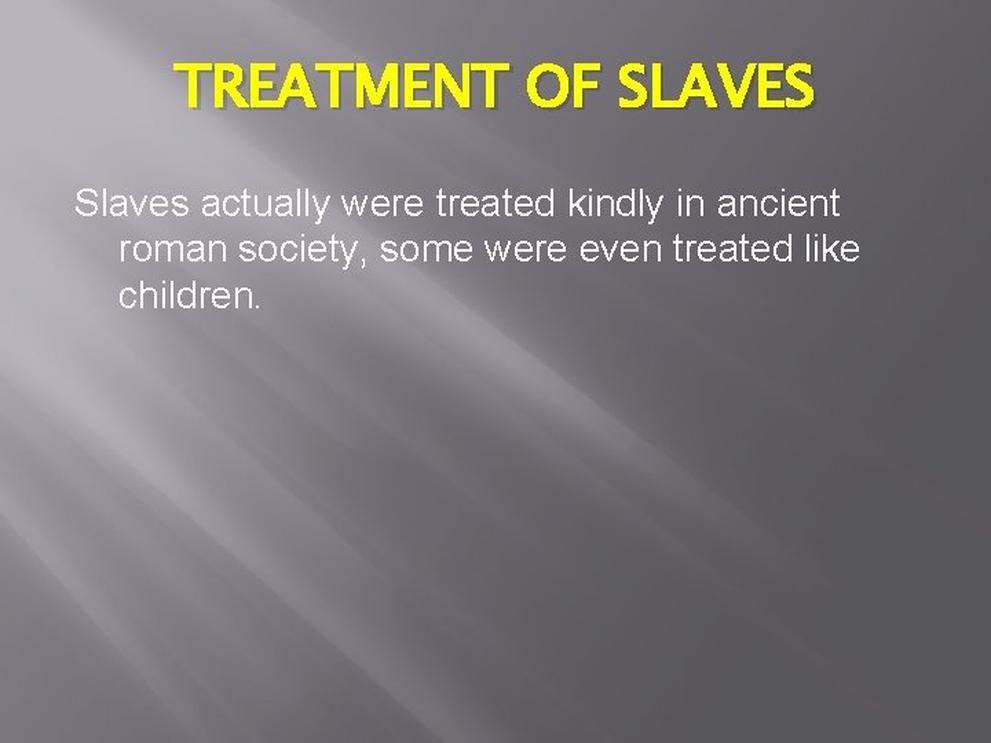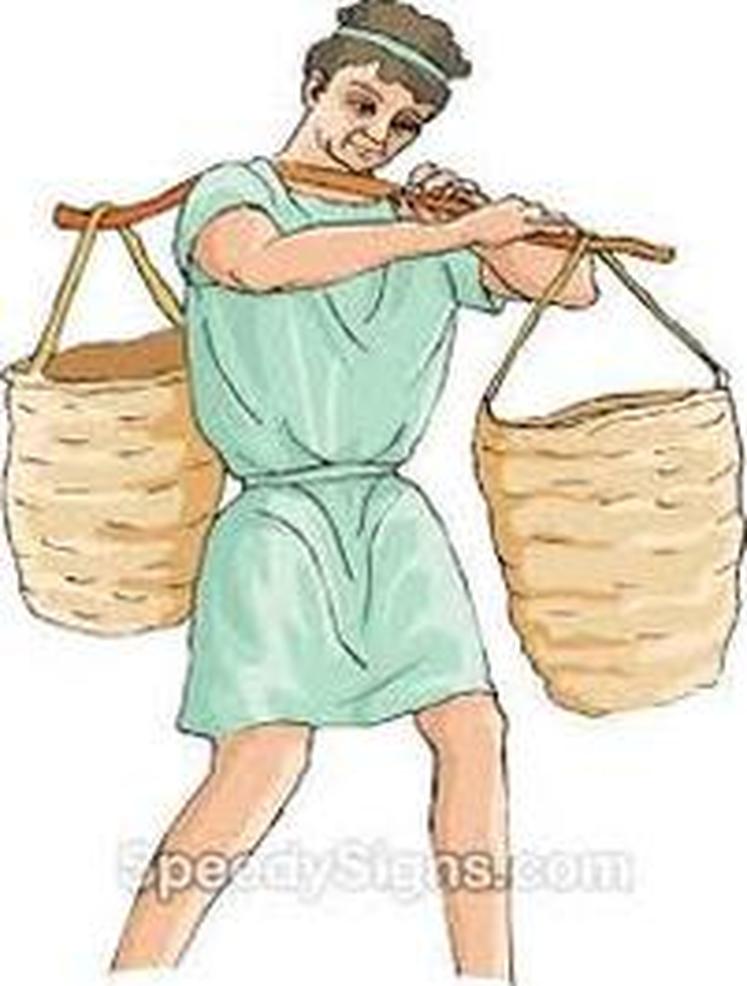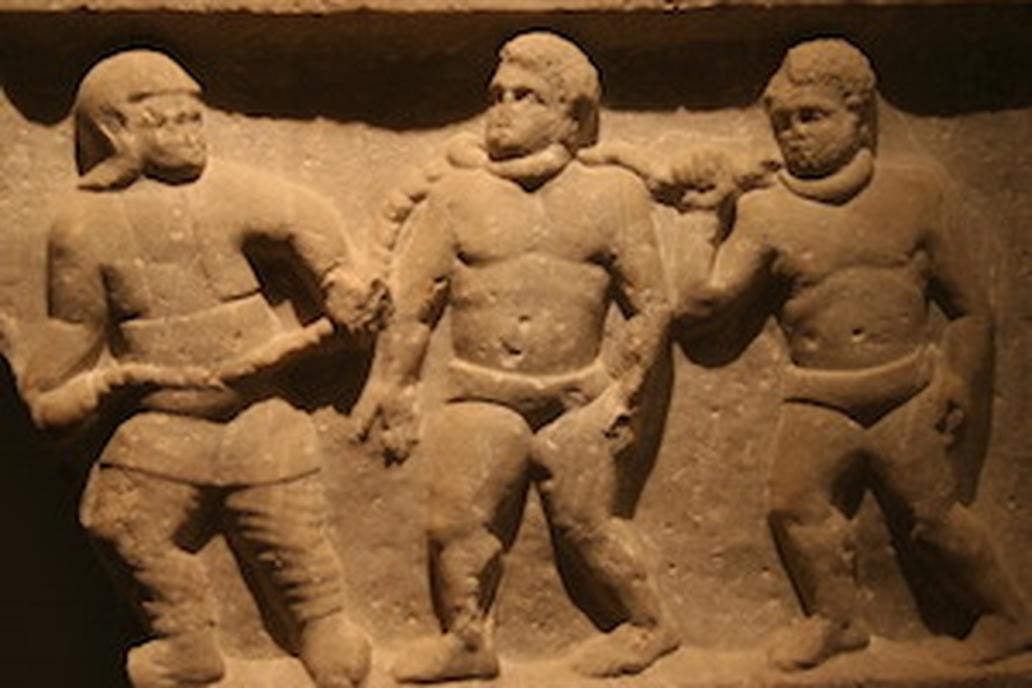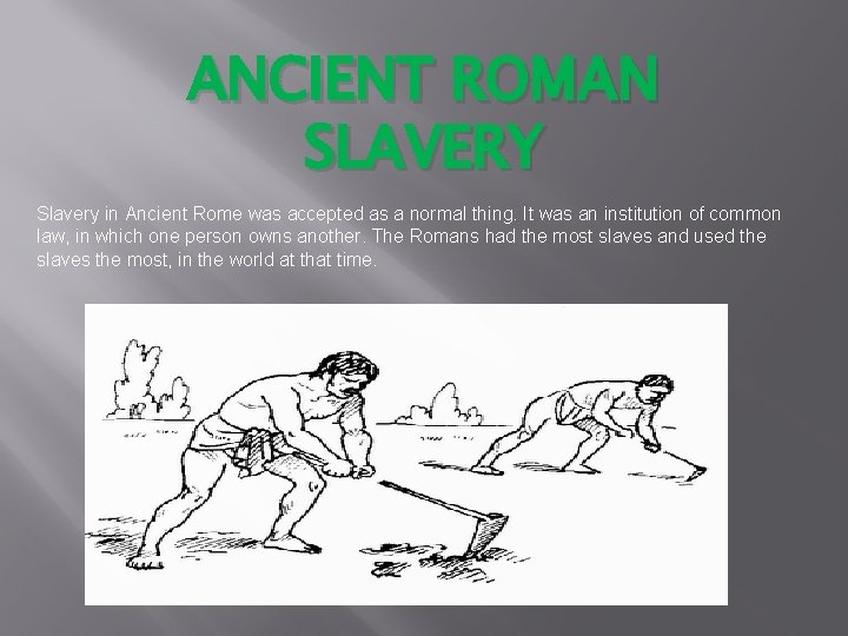Slaves in Ancient Rome were treated as property subject to their masters’ will, but the degree of treatment varied by period, owner, and role. Early Roman slaves had no legal rights and could be killed without consequence, while later reforms following slave revolts introduced protections, including criminal penalties for killing slaves.

In early Rome, slaves were essentially objects owned outright. Their status offered no legal protection or recognition as persons. Masters could punish, mutilate, or even kill them without facing penalties. This brutal treatment reflected a rigid social hierarchy where slaves had no rights or legal standing.
By the late Republic and Imperial periods, this changed somewhat. Following several major slave uprisings, Roman lawmakers imposed limits on slave treatment. Eventually, killing a slave became a punishable offense. Owning and treating slaves well became a measure of elite status, and some owners granted slaves freedom. Freedmen gained partial citizenship, although social prejudice remained. Their children, however, could become full Roman citizens.

Roman slavery was integral to the economy and military expansion. Conquest provided the constant supply of slaves needed to maintain large agricultural estates and urban households. Slaves served as cheap labor supporting the empire’s wealth and growth. When expansion slowed, the economy and society showed signs of stagnation.
Slaves were legally property, extensions of their masters. If a slave committed a crime, the owner was often responsible financially, then punished the slave privately. Despite this, the social hierarchy in Rome allowed for some fluidity through achievements. Slaves who earned freedom and their descendants could integrate into Roman society.

The treatment of slaves varied widely depending on circumstances:
- Gladiators: Not all were slaves, and many were free volunteers. The best fighters were often free men who trained and equipped themselves. Training slaves as gladiators was generally avoided for security reasons.
- Household slaves: Often treated reasonably well, valued as part of the family unit albeit lowest in status. However, abuses, including sexual exploitation, were common especially for women and boys.
- Rural and mining slaves: Suffered the harshest conditions, facing grueling labor, poor living environments, and high mortality rates in mines and large farming estates.
- Personal vs. corporate slaves: Personal slaves usually received better treatment than those owned by businesses or working rural estates.
- Educated slaves: Some slaves with specialized skills or education gained respect and more autonomy, such as Greek tutors or administrators. They could influence their owners and enjoy better living standards.
The religious festival Saturnalia temporarily reversed social roles. Slaves enjoyed freedoms usually denied, including luxury, free speech, and harmlessly mocking masters. This brief respite was symbolic but didn’t alter slavery’s fundamental nature.

Despite incremental legal protections, slaves remained fundamentally non-persons in Roman law. They could be abused, mutilated, or worked to death without legal repercussions for owners. Treatment depended heavily on the master’s character and economic incentives. Slaves were possessions, and masters had wide latitude over their lives.
Language also complicates understanding. Romans lacked terms differentiating slaves from wage workers, lumping all under “slave.” This broad categorization reflected and reinforced their absolute control over those beneath the citizen classes, limiting historical clarity.

Key takeaways:
- Early Roman slaves had no rights; killing a slave was legal.
- Later reforms introduced protections but slaves remained property.
- Treatment varied by role, location, and owner character.
- Slavery fueled Roman economic expansion and decline.
- Freed slaves gained limited rights; their children became citizens.
- Some slaves enjoyed relative autonomy due to education or tasks.
- Saturnalia temporarily reversed social roles between masters and slaves.
- Slaves remained fundamentally non-persons under Roman law.
How Were Slaves Treated in Ancient Rome? Unpacking the Real Story

Slaves in Ancient Rome were treated variably over time, and their treatment depended heavily on their owners, roles, and the era they lived in. Yes, that’s the short answer, but let’s roll up our sleeves and dig deeper—because the story of Roman slavery isn’t just black and white, it’s a complex mosaic of power, social layers, and changing laws.
Imagine being property, literally owned like a desk or a horse. For early Romans, that’s exactly what slaves were. No rights. No protections. Your owner could even kill you without legal consequences. Ouch. This was the harsh reality of early Roman slavery.
But, Rome wasn’t static. After several brutal slave uprisings—aptly called the Servile Wars—the Romans adapted. Laws changed and slowly slaves gained certain rights. By the late Republican and Imperial periods, it became illegal for masters to murder their slaves. More than that, being “good to your slaves” became a mark of prestige. It was literally fashionable to treat your slaves well and some masters even freed them as a show of status.
Slavery: The Engine of Roman Ambition
Here’s a fact: Rome’s drive to conquer and expand was powered massively by the need for slave labor. The bigger the empire got, the more slaves they needed to work the farms, mines, and households that kept the economy buzzing. It’s simple math: More land meant more slaves. More slaves meant more wealth. When expansion slowed, economic growth stumbled, showing just how deeply slavery was tied to Roman success.
Slaves weren’t just unfortunate workers, they were considered property. If a slave messed up, it was the owner’s problem. Owners had to pay fines or face penalties and in turn, they punished their slaves as they saw fit. The chain of responsibility was always from the master to the slave.
Varied Lives of Slaves: From Salt Mines to Dining Rooms
Not all slaves lived the same life. Household slaves often fared better—they were treated as part of the family’s lowest layer, but integrated enough to enjoy some privileges. Some even earned their freedom after years of service. However, household slaves were also vulnerable, especially young girls who could suffer sexual exploitation by their masters. This grim reality contrasts with the brutal existence of slaves working in fields or salt mines, whose lives were short, grueling, and painful. Being sent to the mines was the ultimate punishment, a threat used to keep household slaves in line.
Even within the slave category, personal slaves generally received better care than slaves owned by companies or those who labored in harsh rural conditions. City slaves tended to get less physical work and sometimes had skills or education.
Slaves with Skills: The Case of Posca and Others
Here’s a fascinating tidbit: some slaves were educated, skilled, even respected by their masters. Take Posca, a Greek slave known by Julius Caesar. He wasn’t just a servant; he was a trusted companion allowed to speak freely when alone with Caesar. This kind of relationship wasn’t common but shows the nuances in slave treatment. Not all slaves were dumb laborers; some were advisors, teachers, and skilled artisans.
The Role of Freedom and Social Mobility
Freed slaves—known as freedmen—occupied an interesting place in Roman society. Once freed, they didn’t instantly become full citizens. They still faced social discrimination, a rigid caste remembered their slave past. But the Romans believed social status wasn’t entirely fixed. The children of freedmen born after manumission became full citizens with all rights. So, slavery wasn’t necessarily a permanent stain on a family line.
Social mobility wasn’t a smooth ride, but it was possible, especially if freed slaves or their descendants gained wealth, skills, or connections.
Gladiators: Slaves, Volunteers, or Something Else?
Pop culture often lumps gladiators in with slaves, but the truth is more nuanced. In Imperial Rome, about half of gladiators were slaves, but the other half were free men who voluntarily fought for fame and fortune. The best gladiators could afford to buy their weapons and train full time. Romans feared arming slaves with combat skills; it was seen as risky. So, gladiatorial combat was a mix of forced and voluntary participants. This complicates the typical image of slaves just fighting for their lives in the arena.
Saturnalia: When Slaves Got to Rule the Roost
One cultural gem shines bright in this story: Saturnalia. Imagine a festival where masters wait on their slaves. During this holiday, slaves enjoyed banquets, freedom to come and go, and even free speech without fear of punishment. They could even joke at the expense of their masters—a rare glimpse of social role reversal offering slaves temporary respite and dignity. For a few days, the rigid social order flipped upside down, a momentary taste of liberty and human respect.
The Grim Core: Slaves as Objects
Despite the occasional improvements and cultural nuances, slaves were ultimately non-entities in Roman law. If a master violated a slave, the legal system often remained silent. Rape, mutilation, or sending a slave to die in mines involved little consequence for the owner. Slaves were personal property, and masters had full discretion to treat them as they saw fit. Whether good or cruel largely depended on the owner’s character.
This reality raises challenging questions. How much of a person’s humanity can survive in a system that sees them as “its” property? Romans had no words to separate contract laborers and life-long slaves. For them, social organization boiled down to three groups: patricians, plebeians, and slaves. Everyone under the patricians’ control got lumped into the “slave” category regardless of nuance.
Lessons from Ancient Rome: The Complexity of Slavery
The treatment of slaves in Ancient Rome is a story with many layers. It was shaped by evolving laws, social structure, economic demands, and individual relationships. Slaves could be brutalized or protected, educated or ignored, farm workers or trusted advisers. Some even tasted freedom and citizenship through their children. Yet, at its core, Roman slavery was a system of ownership and dehumanization, with the fate of a slave often resting in the hands of one master.
Could modern society learn from this complexity? Understanding the nuances helps avoid simplistic judgments or myths. Slavery in Rome was cruelty framed by culture but sometimes softened by humanity. The deep tensions between property and personhood, control and resistance, permanence and mobility make Ancient Rome’s slavery a powerful reminder of how power shapes lives radically differently.
So next time you think “Roman slave,” picture a vast range—from the beaten laborer in the mines to the educated Greek companion of Caesar, from the field worker to the master’s trusted house slave, and even the fleeting joy of Saturnalia role reversals. Slavery in Ancient Rome wasn’t just one story—it was many.




